 |
HULKDirector: Ang LeeStarring: Eric Bana, Jennifer Connelly, Sam Elliot, Nick NolteA lab accident gives a scientist superhuman powers, and makes him a threat to the military. WARNING: This review contains minor spoilers!
DISC ONE
The UK disc offers a choice of English Dolby Digital and DTS 5.1 mixes. The Region 1 disc, which also features 5.1 tracks in Spanish and French, does not contain the DTS track. The DTS mix (at 768kbps) is aggressive, with plenty of sound being thrown into all the channels when the Hulk goes ballistic, and more subdued ambient atmospheres in calmer moments. The mix contains plenty of low frequency rumble, too, which viewers with meaty subwoofers will doubtless appreciate. The Dolby Digital mix (at 384kbps) is also impressive, but it's not as good as the DTS track (at 768kbps), which offers subtle improvements, including better imaging and more enveloping ambience. The US disc's Dolby Digital track is presented at 448kbps, so should, in theory, offer a marginal improvement over the UK version's Dolby Digital track. English and Dutch subtitles are provided for the film and the bonus materials. The film is supported by a disappointing, hesitant commentary track by Ang Lee. There are lots of gaps, but when Lee speaks it's generally worth hearing. He doesn't elaborate much on how particular scenes were created, but does address some of the film's specific challenges and problems, talking in general terms about working with his cast and about the leap of imagination the audience must make if they are to accept the CGI Hulk. There's very little information on the disc about how the film developed, and Lee's commentary doesn't expand on this aspect, so you'd be forgiven for thinking that they simply shot the first draft of the script. Perhaps the most interesting part of the commentary is Lee suggesting that people's perception of how film looks (the brightness, particularly) might somehow be related to the colour of their eyes. The film's on-screen captions have been replaced by generic player-generated subtitles, which fail to replicate the original look and style. It is possible to precisely replicate the font, size and position of the captions with player-generated subtitles, but the producers haven't really tried here. The original captions faded in and out, but the player-generated subtitles blink on and off. Shoddy. The American disc features the caption as it was meant to be seen. One of the film's original captions can be seen in The Making of Hulk featurette, on the second disc of the UK set. It's not possible to show exactly the same frame from both versions, because the clip in the featurette is truncated, and the player-generated captions have disappeared by the time the equivalent moment in the documentary clip begins! Here's a comparison, based on what is available:
Unlike the US version, the UK Region 2 discs are a joy to navigate. The American disc has four forced trailers (for 2 Fast 2 Furious, Sinbad: Legend of the Seven Seas, Battlestar Galactica, and Bruce Almighty) before the film appears, which can only be skipped in fast-forward mode. The only trailer on the UK version (a teaser trailer for Thunderbirds) is optional, and selectable from the Bonus menu. Disappointingly, none of the trailers for Hulk are included on the disc. The animated menus are elaborate. Each features a clip of the Hulk in action, which freezes and turns into a comic-strip-like rendition. These clips give away a few plot points, and might spoil the impact of the Hulk's first appearance for viewers who haven't seen the film. Happily the video part of the menus can be skipped using the chapter skip button, making navigation much quicker. Copyright notice screens can be skipped, leaving only the short Universal logo at the beginning to test the viewer's patience.
The BBFC's online database has kindly broken down the Inside The Rage material into its component parts: (The figures on the left are the durations in minutes, seconds and frames) 01:02:02
- Bruce saves assistant in lab DISC TWO Disc two is where you'll find the bulk of the bonus material, broken down into nine sections: Hulkification, Evolution of the Hulk, The Incredible Ang Lee, The Dog Fight Scene, The Unique Style of Editing Hulk, The Making of Hulk, Deleted Scenes, Anatomy of the Hulk and DVD-Rom Materials. Like it or not, all this material is all presented in full-screen 4:3 ratio. Much of it uses the split-screen technique, making it easy to compare special effects shots before and after they've been completed, or to watch a scene being shot from a different angle, alongside the finished sequence, for example. As usual the bonus material has been sourced from NTSC recordings, and standards converted. This has no appreciable effect during playback, but means that using in pause mode still frames are often interpolated (a mixture of two or more frames). HULKIFICATION
EVOLUTION OF THE HULK (16m) A breathless potted history of Marvel comics, and of the Hulk character in particular, followed by a look at the various screen incarnations of the Hulk, eventually concentrating on the 2003 version. It includes interviews with creator Stan Lee and Marvel's Avi Arad. This featurette includes clips from Frankenstein (1931) and Doctor Jekyll and Mr Hyde (Universal's 1913 version, starring King Baggot). THE INCREDIBLE ANG LEE (14m)
THE DOG FIGHT SCENE (10m) One of the film's action set pieces involves the Hulk being attacked by three hellish dogs who have been boosted by the same super-strength-giving properties. It sticks out like a sore thumb in the film. It was designed as an epic sequence, featuring more than 200 shots, and about fifteen million dollars worth of CGI effects. In the end the scene was scaled down, and this featurette examines its creation. It focuses on the CGI aspect, but the disc includes shots where it looks like the producers used simple puppetry. THE UNIQUE STYLE OF EDITING HULK (6m) An overview of the film's editing style, which attempts to mimic the look of a comic strip (with the use of split screen and fancy transitions between shots). Editor Tim Squyres explains the concept, Ang Lee describes some of the problems involved, and ILM's Mark Casey explains how some of the effects were achieved. THE MAKING OF HULK (24m)
DELETED SCENES (6m) There are six deleted scenes: Betty and Bruce's presentation of their nanomed research findings to their colleagues at the Institute; a late-night phone call between Betty and Bruce; a flashback to Bruce's school days, with a caption that says "Awakening", where a young woman teases him, triggering Banner's rage (we only see the initial stage of the transformation); a short exchange between General Ross and the Mayor during the pursuit of the Hulk (this seems like a cameo role for someone, but the actor playing the Mayor isn't identified); a short conversation between Bruce and a security guard (a cameo appearance by TV's The Incredible Hulk, Lou Ferrigno); and a scene of men in suits removing research equipment from Betty's home. The first scene is unfinished, (there's some dialogue missing (which is filled-in by another voice), and it has captions recounting the dialogue. The others seem more or less finished, complete with music, although they're presented in dark and murky non-anamorphic widescreen format, with stereo audio. ANATOMY OF THE HULK A fun, fact-filled look at the Hulk, presented in standard DVD menu format. Clicking on the Hulk's various body parts leads to a short clip illustrating some aspect of his superhuman powers (here you'll find out that, if he wore shoes, he'd be a size 87, and that he can run at 300mph, for example). There are also a few short clips showing the development of the CGI character at ILM. DVD ROM MATERIALS The DVD-Rom bonus features require the installation of the horrible InterActual PC Friendly software. Poking around in the files suggests there's a screensaver and some wallpapers. SUMMARY - WHICH VERSION TO GET? The UK disc offers a knockout DTS 5.1 audio track, which isn't on the US version. This must surely be the deciding factor for many potential customers. The US disc features a couple of Hulk-related TV adverts for Sunny D and an advert for a Universal Mastercard credit card. The US disc also features a playable level of a Hulk video game, when the disc is played in an Xbox. Unless they're hidden away as Easter Eggs, these features are missing from the UK disc. The US disc features four forced trailers, none of which are for Hulk. The US set has the film's original caption burnt into the image; the UK disc has a player-generated subtitle. A limited edition box set is also available in the UK and Australia, with various printed supplements (storyboard art prints, a production notes booklet, a complete presentation of the artwork featured in the disc's Hulkification featurette, and a reprint of the first issue of The Incredible Hulk comic, from May 1962) and a bonus DVD, featuring a forty-five minute behind the scenes documentary hosted by Sam Elliot and Josh Lucas, titled Hulk: The Lowdown. (This disc wasn't available for review). The Australian version of the disc appears to be identical to the the UK release. Note - early reports that the Region 4 version had a full-bitrate DTS track are erroneous - it's encoded at 768kbps, the same as the UK disc. |


 Ang
Lee's Hulk is a misguided attempt to bring dramatic and emotional depth to
a comic-strip-inspired story. Fans of relatively superficial films like
Ang
Lee's Hulk is a misguided attempt to bring dramatic and emotional depth to
a comic-strip-inspired story. Fans of relatively superficial films like  The
film is presented in 1.85:1 ratio, with anamorphic enhancement. The
picture quality
is extremely good, with virtually perfect contrast, black levels and colour
fidelity. The film's colour scheme has a pop art look with bold
primary colours, akin to
movies like The Final Programme (1973) and Dick Tracy (1990).
The transfer also has to accommodate more subtle hues (notably the
green tinting when Bruce Banner morphs into the Hulk), and does so
admirably. The image is generally clean
and sharp. It's probably as good as possible, given the limitations of the
format, but it isn't pin-sharp. There's
a smidgeon of edge-enhancement visible, most prominently on split-screen
shots with black borders contrasting with light backgrounds, but the film
is restless, and usually doesn't give the viewer time to dwell on its
shortcomings. The
average bitrate is a reasonable 6.46 Mb/s.
The
film is presented in 1.85:1 ratio, with anamorphic enhancement. The
picture quality
is extremely good, with virtually perfect contrast, black levels and colour
fidelity. The film's colour scheme has a pop art look with bold
primary colours, akin to
movies like The Final Programme (1973) and Dick Tracy (1990).
The transfer also has to accommodate more subtle hues (notably the
green tinting when Bruce Banner morphs into the Hulk), and does so
admirably. The image is generally clean
and sharp. It's probably as good as possible, given the limitations of the
format, but it isn't pin-sharp. There's
a smidgeon of edge-enhancement visible, most prominently on split-screen
shots with black borders contrasting with light backgrounds, but the film
is restless, and usually doesn't give the viewer time to dwell on its
shortcomings. The
average bitrate is a reasonable 6.46 Mb/s.
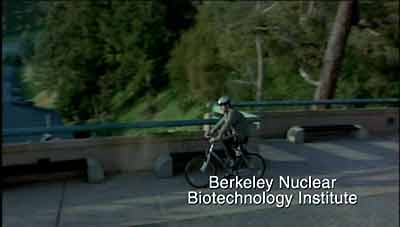
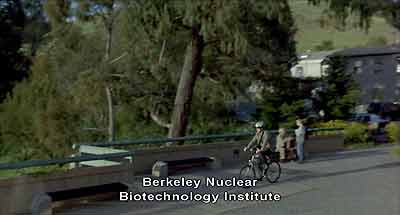
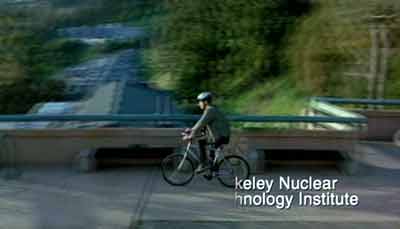
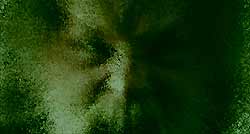 Aside
from the commentary track, the main supporting feature on disc one is the Inside The Rage mode, which offers
viewers cutaways to eighteen minutes of additional, unadorned behind the scenes
material. In this mode a symbol will appear on-screen at the relevant
point in the film. Selecting it opts out of the film to watch
behind-the-scenes bonus footage (ala The Matrix's White Rabbit feature).
Either by luck or design, you can use the chapter skip button to move from one
enhanced scene to another, meaning you don't have to watch the whole film
to access the extra material.
Aside
from the commentary track, the main supporting feature on disc one is the Inside The Rage mode, which offers
viewers cutaways to eighteen minutes of additional, unadorned behind the scenes
material. In this mode a symbol will appear on-screen at the relevant
point in the film. Selecting it opts out of the film to watch
behind-the-scenes bonus footage (ala The Matrix's White Rabbit feature).
Either by luck or design, you can use the chapter skip button to move from one
enhanced scene to another, meaning you don't have to watch the whole film
to access the extra material.
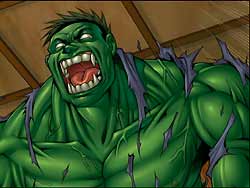 A two-minute clip of one of the
transformation scenes is interpreted by four acclaimed comic book artists
(Adam Kubert, Tommy Ohtsuka, Salvador Larroca and Katsuya Terada). The
storyboards for this sequence are also available, and comparisons between
the film and each artist's interpretations are fascinating. It's also
interesting to compare the comic art to the storyboards, and see how it
takes the comic artists far fewer panels to convey the scene than the film
or it's storyboards. The presentation of these sequences is a little
awkward. For each one a split-screen version is offered, showing the film
clip, the pencil artwork and the finished art. From there the user can
select any of the three versions, which are then offered full-frame.
Jumping between them is virtually impossible. This section is billed as
multi-angle, but you can't change angles on the fly, so it's probably been
accomplished by branching. The artwork is jazzed up by using zooms and
pans, which somewhat ruins the point of the comparison. There's no way,
for example, of seeing each page of art as the artist laid it out, and
often you don't get a clear view of an entire panel.
A two-minute clip of one of the
transformation scenes is interpreted by four acclaimed comic book artists
(Adam Kubert, Tommy Ohtsuka, Salvador Larroca and Katsuya Terada). The
storyboards for this sequence are also available, and comparisons between
the film and each artist's interpretations are fascinating. It's also
interesting to compare the comic art to the storyboards, and see how it
takes the comic artists far fewer panels to convey the scene than the film
or it's storyboards. The presentation of these sequences is a little
awkward. For each one a split-screen version is offered, showing the film
clip, the pencil artwork and the finished art. From there the user can
select any of the three versions, which are then offered full-frame.
Jumping between them is virtually impossible. This section is billed as
multi-angle, but you can't change angles on the fly, so it's probably been
accomplished by branching. The artwork is jazzed up by using zooms and
pans, which somewhat ruins the point of the comparison. There's no way,
for example, of seeing each page of art as the artist laid it out, and
often you don't get a clear view of an entire panel.
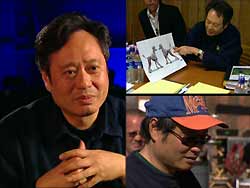 This featurette explains what unique talents Lee
was able to bring to the role, and includes valedictions from his key
contributors. If there was one key message conveyed in the film's TV
publicity, it was that Lee himself was used as the basis for the Hulk;
acting out the character's rage in a motion capture jumpsuit. Heaven knows
what Eric Bana, the actor that Lee had hired for the role, thought about
this. The featurette shows Lee in action, with a few split-screen
sequences showing how precisely Lee's movement was transcribed to the CGI
Hulk. The featurette seems to go out of its way to show how involved Lee
was with every aspect of the production, but you get the impression that
he was not best suited for this type of production. This featurette also looks at the contribution of composer Danny
Elfman, and how Lee pushed his creativity.
This featurette explains what unique talents Lee
was able to bring to the role, and includes valedictions from his key
contributors. If there was one key message conveyed in the film's TV
publicity, it was that Lee himself was used as the basis for the Hulk;
acting out the character's rage in a motion capture jumpsuit. Heaven knows
what Eric Bana, the actor that Lee had hired for the role, thought about
this. The featurette shows Lee in action, with a few split-screen
sequences showing how precisely Lee's movement was transcribed to the CGI
Hulk. The featurette seems to go out of its way to show how involved Lee
was with every aspect of the production, but you get the impression that
he was not best suited for this type of production. This featurette also looks at the contribution of composer Danny
Elfman, and how Lee pushed his creativity.
 This
section is broken down into four sections: Cast and Crew, Stunts and
Physical Effects, ILM and Music. There's a "Play All" option,
too. The Cast and Crew section is the usual back-slapping and superficial
character analysis, but includes deserved praise for supporting actors Sam
Elliot (who plays the villainous General Ross) and Josh Lucas (Talbot).
Stunts and Physical Effects deals with the Hulk character's interaction
with the real world, in particular a sequence where the Hulk smashes up a
laboratory. The ILM section contains lots of footage of the Hulk CGI
character in various stages of development, including lots of very cool
prototype footage. About half the Music section is devoted to composer
Danny Elfman, who's become the composer of choice for Superhero movies (Batman,
Spider-Man, Darkman, etc). His work on Hulk is
atypical, but still distinctly Elfman. The rest of the Music section
focuses on the movie's lead song, Set Me Free, featuring brief
contributions from former Guns 'n' Roses guitarist Slash and Stone Temple
Pilots' Scott Weiland.
This
section is broken down into four sections: Cast and Crew, Stunts and
Physical Effects, ILM and Music. There's a "Play All" option,
too. The Cast and Crew section is the usual back-slapping and superficial
character analysis, but includes deserved praise for supporting actors Sam
Elliot (who plays the villainous General Ross) and Josh Lucas (Talbot).
Stunts and Physical Effects deals with the Hulk character's interaction
with the real world, in particular a sequence where the Hulk smashes up a
laboratory. The ILM section contains lots of footage of the Hulk CGI
character in various stages of development, including lots of very cool
prototype footage. About half the Music section is devoted to composer
Danny Elfman, who's become the composer of choice for Superhero movies (Batman,
Spider-Man, Darkman, etc). His work on Hulk is
atypical, but still distinctly Elfman. The rest of the Music section
focuses on the movie's lead song, Set Me Free, featuring brief
contributions from former Guns 'n' Roses guitarist Slash and Stone Temple
Pilots' Scott Weiland.